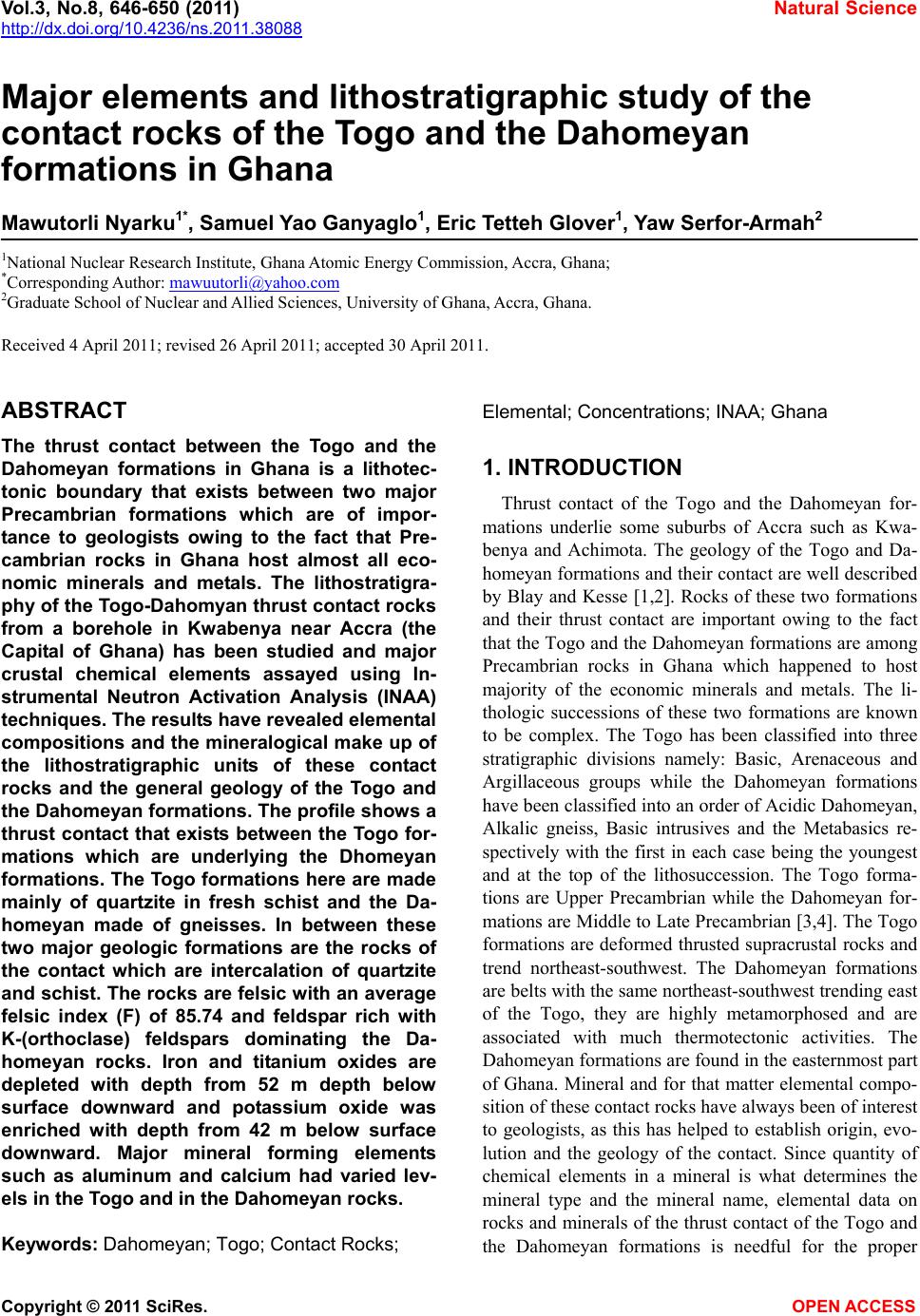
Vol.3, No.8, 646-650 (2011) Natural Science
http://dx.doi.org/10.4236/ns.2011.38088
Copyright © 2011 SciRes. OPEN ACCESS
Major elements and lithostratigraphic study of the
contact rocks of the Togo and the Dahomeyan
formations in Ghana
Mawutorli Nyarku1*, Samuel Yao Ganyaglo1, Eric Tetteh Glover1, Yaw Serfor-Armah2
1National Nuclear Research Institute, Ghana Atomic Energy Commission, Accra, Ghana;
*Corresponding Author: mawuutorli@yahoo.com
2Graduate School of Nuclear and Allied Sciences, University of Ghana, Accra, Ghana.
Received 4 April 2011; revised 26 April 2011; accepted 30 April 2011.
ABSTRACT
The thrust contact between the Togo and the
Dahomeyan formations in Ghana is a lithotec-
tonic boundary that exists between two major
Precambrian formations which are of impor-
tance to geologists owing to the fact that Pre-
cambrian rocks in Ghana host almost all eco-
nomic minerals and metals. The lithostratigra-
phy of the Togo-Dahomyan thrust contact rocks
from a borehole in Kwabenya near Accra (the
Capital of Ghana) has been studied and major
crustal chemical elements assayed using In-
strumental Neutron Activation Analysis (INAA)
techniques. The results have revealed elemental
compositions and the mineralogical make up of
the lithostratigraphic units of these contact
rocks and the general geology of the Togo and
the Dahomeyan formations. The profile shows a
thrust contact that exists between the Togo for-
mations which are underlying the Dhomeyan
formations. The Togo formations here are made
mainly of quartzite in fresh schist and the Da-
homeyan made of gneisses. In between these
two major geologic formations are the rocks of
the contact which are intercalation of quartzite
and schist. The rocks are felsic with an average
felsic index (F) of 85.74 and feldspar rich with
K-(orthoclase) feldspars dominating the Da-
homeyan rocks. Iron and titanium oxides are
depleted with depth from 52 m depth below
surface downward and potassium oxide was
enriched with depth from 42 m below surface
downward. Major mineral forming elements
such as aluminum and calcium had varied lev-
els in the Togo and in the Dahomeyan rocks.
Keywords: Dahomeyan; Togo; Contact Rocks;
Elemental; Concentrations; INAA; Ghana
1. INTRODUCTION
Thrust contact of the Togo and the Dahomeyan for-
mations underlie some suburbs of Accra such as Kwa-
benya and Achimota. The geology of the Togo and Da-
homeyan formations and their contact are well described
by Blay and Kesse [1,2]. Rocks of these two formations
and their thrust contact are important owing to the fact
that the Togo and the Dahomeyan formations are among
Precambrian rocks in Ghana which happened to host
majority of the economic minerals and metals. The li-
thologic successions of these two formations are known
to be complex. The Togo has been classified into three
stratigraphic divisions namely: Basic, Arenaceous and
Argillaceous groups while the Dahomeyan formations
have been classified into an order of Acidic Dahomeyan,
Alkalic gneiss, Basic intrusives and the Metabasics re-
spectively with the first in each case being the youngest
and at the top of the lithosuccession. The Togo forma-
tions are Upper Precambrian while the Dahomeyan for-
mations are Middle to Late Precambrian [3,4]. The Togo
formations are deformed thrusted supracrustal rocks and
trend northeast-southwest. The Dahomeyan formations
are belts with the same northeast-southwest trending east
of the Togo, they are highly metamorphosed and are
associated with much thermotectonic activities. The
Dahomeyan formations are found in the easternmost part
of Ghana. Mineral and for that matter elemental compo-
sition of these contact rocks have always been of interest
to geologists, as this has helped to establish origin, evo-
lution and the geology of the contact. Since quantity of
chemical elements in a mineral is what determines the
mineral type and the mineral name, elemental data on
rocks and minerals of the thrust contact of the Togo and
the Dahomeyan formations is needful for the proper